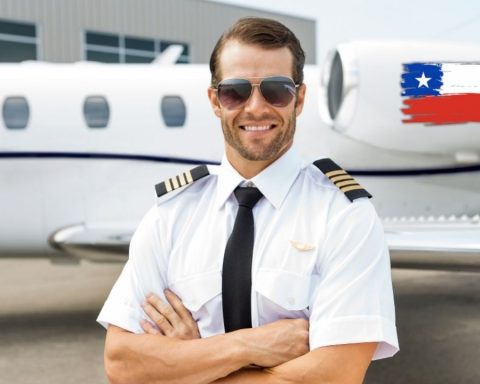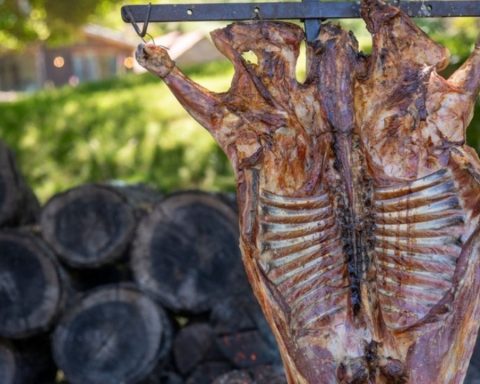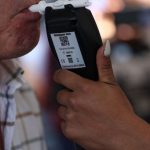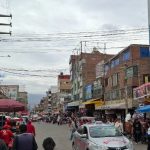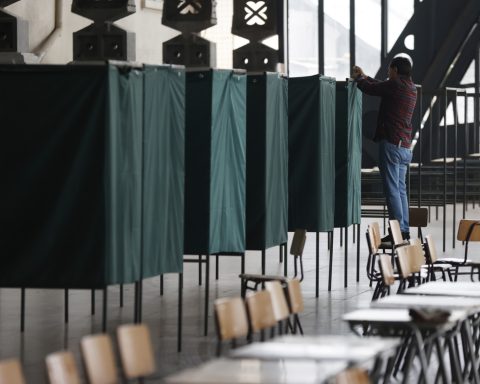Arica is sand-colored, with a backdrop of low, dusty hills, which have been filled with shacks, shacks, shanty towns, shanty towns, camps. All the Latin American synonyms for those places where extreme poverty and vulnerability reside, apply to what is generically known as Cerro Chuño.
It is Ñamérica in its purest form, would say the Argentine journalist and writer Martín Caparrós, author of the homonymous essay, in which he rescues the Ñ as a sign of Latin American identity.
The Ñ of ChuÑo
From any point in the city, you can see the pile of cans, boards, various debris that grows and grows, along with irregular migration, in those hard dunes, where signs of life seem scarce. Those who know something estimate its population at about 2 thousand people. Although since law and order only come in to carry out raids and specific police operations, the number could be much higher.
Now, after lunch and when the sun rises, not a soul is to be seen. At the beginning of the main street, which once had a better pavement and continues up the hill as the only access road to the city dump, there is a ranch that pays tribute to the evil of Diogenes. Among all sorts of junk, furniture and garbage, a family of African-American adults who could be Colombians or Venezuelans or Dominicans, contemplates the panorama with a face of few friends with the music at full blast.
Our guide says that it is better not to stop. Here you come by invitation and onlookers are not welcome.
“You can go to Cerro ChuÑo, but with a strategy,” warns Nina Consuegra, president of the Colombian Union and the Communal Union of Migrants in Arica since May 2022, who arrived in Arica in 2005 and has lived in Chile for 22 years . Nina works with Acción Solidaria, an organization of Hogar de Cristo, which supports organized society groups that do social work. She explains:
“Cerro ChuÑo is divided into two: the Morrillo part and the Cochancas part. Cochancas has its main road. Before going up there, I give notice to some Colombian friends so that they can go down and they get on my truck to be able to access the place in their company. I had to go some time ago as a result of some fires in which eight Colombian families lost everything. I uploaded merchandise, but in a coordinated manner, advising them to wait for me in a specific place. They took the boxes with help and that’s it. There one sees young people smoking marijuana, taking drugs, in full view and patience of those who pass by, you always see people digging through the garbage. Nothing has ever happened to me, thank God, but everyone says I’m brave for going there.”
Nina goes less and less, except when an emergency occurs, such as fires, which are frequent in the place. With so much trash and so much sun, it’s not uncommon for spontaneous combustion to occur and shacks to burn.

Nina Consuegra, president of the Colombian Union and the Communal Union of Migrants in Arica.
a kidnapped woman
Mario Carrera has been the Regional Prosecutor of Arica and Parinacota since January 2021, the year in which homicides in the region, of a level of violence never seen before, impacted the country.
Cerro ChuÑo de Arica, which was known as a sacrifice zone, where lead contamination forced the eviction and demolition of homes, after which it was populated like any camp in Chile, in 2022, made the news as the place of residence of the members of El Tren de Aragua. Not only residence, but also “work”, including kidnapping and torture centers.
In this vast hill of Arica without any heroic past or tourist virtues, they only go up the trucks that take the garbage to the dump and the Chileans living in extreme poverty and vulnerability, the undocumented migrants and the members of this mafia of Venezuelan origin that has been terrorizing all those who resist it.
It was there that the PDI, by order of prosecutor Carrera, discovered the corpse of one of their “soldiers” in June of last year. The body had been underground for about a month and showed signs of torture. The police report says: “Body buried in Cerro Chuño. Cause: Aragua train. Venezuelan victim: José Alejandro Nino Graterol”.
The Regional Prosecutor explains the profile of the members of the dangerous group, born in the Tocorón prison in Aragua, Venezuela. “There are certainly more men than women. They are in charge of the business of prostitution, of human trafficking; It is a very macho organization. There is no lieutenant in a prominent position, ”he explains. And he gives more details:
“It is made up of young men, real soldiers. Unlike other criminal groups, they do not indulge in consumer boasts, despite the fact that on occasions they may have many millions of pesos in their pockets or kilos of coke in their possession. They are not into buying cars or houses or live ostentatiously. The precariousness in which they live is impressive, with minimal survival. The soldiers must show that they are choros, that they can do it, that they are capable of doing everything that is ordered to them. Everything. As their origin is prison “Their logic is that of the prison. The body buried and with signs of torture in a ranch on Cerro ChuÑo corresponds to a Venezuelan whom we had in the organization chart. It was clearly someone who strayed from the path, who did not comply with what he expected of him.”
-Is Cerro Chuño no man’s land? Can anyone come and go safely?
-It is a takeover in which migrants, in addition to Chileans, began to settle. There is a strong presence of Colombians, Bolivians and then the Venezuelans began to arrive, taking people of other nationalities. It is estimated that about two thousand people live there. And, yes, it is a dangerous place that city dwellers do not venture. It is an area that offers a very powerful degree of protection to criminal gangs. As it is a hill, it allows to warn what is coming. Anticipate the operations. It is a very conflictive area for the city.
Prosecutor Carrera is a man seasoned in criminal matters. But, despite this, he maintains that what impresses and worries him the most is “the vulnerability of women subjected to the crime of human trafficking for the purpose of sexual exploitation.”
Comment on a specific case:
“There is that of a woman who was kidnapped for several days in a hut on Cerro ChuÑo because she refused to pay half of what she received for her sexual services weekly. It was highly publicized. I am concerned about how we protect that victim I don’t want her to be in the trial because of the risk that this exposure means for her. I feel that there is not enough measure that can guarantee her safety. Chile lacks a lot as a State in terms of protection of victims and witnesses. We need international agreements , plans with greater height. Chile is a small country and it is not so difficult for these groups to locate it within the country; I feel that today we do not have the tools to give it protection.”

Mario Carrera, Regional Prosecutor of Arica and Parinacota.
A ranch with four tables
Nina Consuegra describes four waves of Venezuelan migration since the exodus began. The fourth, most recent, she claims, is bad. “Not in its entirety, it cannot be generalized, but it is mostly criminal. With it begins the wave of violence in cities like Arica, which was previously a territory of peace. Crimes did not happen here. You could go out at night without any risk. We went from zero murders to two and three per week. And the notice of the presence of the Araugua Train is real. It is common today to hear versions of “my son is missing in Arica” or “they are extorting me” and things like that.
And continues:
“I already told you that Cerro ChuÑo is divided into a sector that is very bad and another that is bad at the back and good at the front. In the whole hill there are not only migrants, old and new Chileans also live there. There is a law by which semi-annual pardons prisoners from saturated local jails. In Arica, 261 inmates benefited from this program last year. I wonder: How many of them are really rehabilitated to reintegrate into society? I have been told that the percentage is minimal. And they all go to live in Cerro ChuÑo.”
Anyone can, says the leader, build a hut with “four wooden boards and settle there. Nobody tells you anything and everyone sees how they manage later. The part of Morrillo was populated by Dominicans, who lived in the city and, not getting a visa and being able to regularize, they took land, built their shacks and live there for free.
He adds about his compatriots, the Colombians:
“Colombians are scandalous, they like to drink beer and listen to music at full volume. Many migrated to Cerro ChuÑo for this reason, the poor coexistence due to cultural reasons. I was very sad that many had to go and live there due to these circumstances. And then it began to be populated by Venezuelans.”
Nina regrets that today they pay just for sinners and Chileans absolutely associate migration with crime. She maintains that it has been the Government, this and the previous ones, that “did not put a shortcut to this situation at the time. Thus, the gap is growing day by day, because the authorities do not want to see that where there is one ranch today, tomorrow there will be three and the day after nine. That doing nothing allows the precarious settlement to continue spreading.”
It is also impressive that those responsible seem not to see that families, the elderly, children and young people live there, without services or networks or access to anything. “I know that many pay for water, that it arrives by truck, and that the majority is hanging from electricity,” says Nina, saddened by the fate of those who, due to their vulnerability, have no other option than Cerro ChuÑo.
“Downstairs, on Capitán Ávalos avenue, there is the Leonardo da Vinci School, where the children go, because I know many migrant workers who have no choice but to live there, but they are people who contribute to the development of Arica.”
We, on our visit to the apparently uninhabited Cerro ChuÑo, see almost no one.
A couple of people digging through the garbage, a skinny and absolutely drugged woman who lights a fire, the incessant circulation of trucks loaded with garbage along a road lined with stinking garbage, where the smell of corpses prevails, the shacks in several of the which wave Colombian and Venezuelan flags and signs with the same meaningless warning: “Littering is prohibited.”




